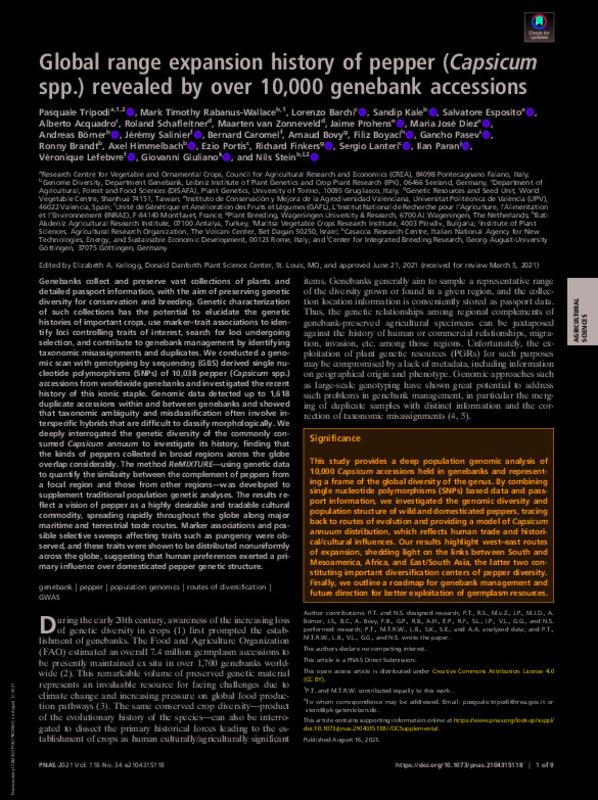JavaScript is disabled for your browser. Some features of this site may not work without it.
Buscar en RiuNet
Listar
Mi cuenta
Estadísticas
Ayuda RiuNet
Admin. UPV
Global range expansion history of pepper (Capsicum spp.) revealed by over 10,000 genebank accessions
Mostrar el registro sencillo del ítem
Ficheros en el ítem
| dc.contributor.author | Tripodi, Pasquale
|
es_ES |
| dc.contributor.author | Rabanus-Wallace, Mark Timothy
|
es_ES |
| dc.contributor.author | Barchi, Lorenzo
|
es_ES |
| dc.contributor.author | Kale, Sandip
|
es_ES |
| dc.contributor.author | Esposito, Salvatore
|
es_ES |
| dc.contributor.author | Acquadro, Alberto
|
es_ES |
| dc.contributor.author | Schafleitner, Roland
|
es_ES |
| dc.contributor.author | van Zooneveld, Maarten
|
es_ES |
| dc.contributor.author | Prohens Tomás, Jaime
|
es_ES |
| dc.contributor.author | Díez Niclós, Mª José Teresa De Jesús
|
es_ES |
| dc.contributor.author | Börner, Andreas
|
es_ES |
| dc.contributor.author | Salinier, Jérémy
|
es_ES |
| dc.contributor.author | Caromel, Bernard
|
es_ES |
| dc.contributor.author | Bovy, Arnaud
|
es_ES |
| dc.contributor.author | Boyaci, Filiz
|
es_ES |
| dc.contributor.author | Pasev, Gancho
|
es_ES |
| dc.contributor.author | Brandt, Ronny
|
es_ES |
| dc.contributor.author | Himmelbach, Axel
|
es_ES |
| dc.contributor.author | Portis, Ezio
|
es_ES |
| dc.contributor.author | Finkers, Richard
|
es_ES |
| dc.contributor.author | Lanteri, Sergio
|
es_ES |
| dc.contributor.author | Paran, Ilan
|
es_ES |
| dc.contributor.author | Lefebvre, Véronique
|
es_ES |
| dc.contributor.author | Giuliano, Giovanni
|
es_ES |
| dc.contributor.author | Stein, Nils
|
es_ES |
| dc.date.accessioned | 2023-11-10T19:05:24Z | |
| dc.date.available | 2023-11-10T19:05:24Z | |
| dc.date.issued | 2021-08-24 | es_ES |
| dc.identifier.issn | 0027-8424 | es_ES |
| dc.identifier.uri | http://hdl.handle.net/10251/199528 | |
| dc.description.abstract | [EN] Genebanks collect and preserve vast collections of plants and detailed passport information, with the aim of preserving genetic diversity for conservation and breeding. Genetic characterization of such collections has the potential to elucidate the genetic histories of important crops, use marker¿trait associations to identify loci controlling traits of interest, search for loci undergoing selection, and contribute to genebank management by identifying taxonomic misassignments and duplicates. We conducted a genomic scan with genotyping by sequencing (GBS) derived single nucleotide polymorphisms (SNPs) of 10,038 pepper (Capsicum spp.) accessions from worldwide genebanks and investigated the recent history of this iconic staple. Genomic data detected up to 1,618 duplicate accessions within and between genebanks and showed that taxonomic ambiguity and misclassification often involve interspecific hybrids that are difficult to classify morphologically. We deeply interrogated the genetic diversity of the commonly consumed Capsicum annuum to investigate its history, finding that the kinds of peppers collected in broad regions across the globe overlap considerably. The method ReMIXTURE¿using genetic data to quantify the similarity between the complement of peppers from a focal region and those from other regions¿was developed to supplement traditional population genetic analyses. The results reflect a vision of pepper as a highly desirable and tradable cultural commodity, spreading rapidly throughout the globe along major maritime and terrestrial trade routes. Marker associations and possible selective sweeps affecting traits such as pungency were observed, and these traits were shown to be distributed nonuniformly across the globe, suggesting that human preferences exerted a primary influence over domesticated pepper genetic structure. | es_ES |
| dc.description.sponsorship | We are gratefully acknowledge Annette Marlow, Beate Kamm, Jacqueline Pohl, Susanne Konig, Ines Walde, Mary Ziems, and Anne Massire for technical assistance. We wish to acknowledge the G2P-SOL proj-ect, funded by the European Union Horizon 2020 research and innovation program under Grant Agreement No. 677379. | es_ES |
| dc.language | Inglés | es_ES |
| dc.publisher | Proceedings of the National Academy of Sciences | es_ES |
| dc.relation.ispartof | Proceedings of the National Academy of Sciences | es_ES |
| dc.rights | Reconocimiento (by) | es_ES |
| dc.subject | Genebank | es_ES |
| dc.subject | Pepper | es_ES |
| dc.subject | Population genomics | es_ES |
| dc.subject | Routes of diversification | es_ES |
| dc.subject | GWAS | es_ES |
| dc.subject.classification | GENETICA | es_ES |
| dc.title | Global range expansion history of pepper (Capsicum spp.) revealed by over 10,000 genebank accessions | es_ES |
| dc.type | Artículo | es_ES |
| dc.identifier.doi | 10.1073/pnas.2104315118 | es_ES |
| dc.relation.projectID | info:eu-repo/grantAgreement/EC/H2020/677379/EU | es_ES |
| dc.rights.accessRights | Abierto | es_ES |
| dc.contributor.affiliation | Universitat Politècnica de València. Escuela Técnica Superior de Ingeniería Agronómica y del Medio Natural - Escola Tècnica Superior d'Enginyeria Agronòmica i del Medi Natural | es_ES |
| dc.description.bibliographicCitation | Tripodi, P.; Rabanus-Wallace, MT.; Barchi, L.; Kale, S.; Esposito, S.; Acquadro, A.; Schafleitner, R.... (2021). Global range expansion history of pepper (Capsicum spp.) revealed by over 10,000 genebank accessions. Proceedings of the National Academy of Sciences. 118(34):1-9. https://doi.org/10.1073/pnas.2104315118 | es_ES |
| dc.description.accrualMethod | S | es_ES |
| dc.relation.publisherversion | https://doi.org/10.1073/pnas.2104315118 | es_ES |
| dc.description.upvformatpinicio | 1 | es_ES |
| dc.description.upvformatpfin | 9 | es_ES |
| dc.type.version | info:eu-repo/semantics/publishedVersion | es_ES |
| dc.description.volume | 118 | es_ES |
| dc.description.issue | 34 | es_ES |
| dc.identifier.pmid | 34400501 | es_ES |
| dc.identifier.pmcid | PMC8403938 | es_ES |
| dc.relation.pasarela | S\461414 | es_ES |
| dc.contributor.funder | European Commission | es_ES |
| dc.subject.ods | 02.- Poner fin al hambre, conseguir la seguridad alimentaria y una mejor nutrición, y promover la agricultura sostenible | es_ES |








